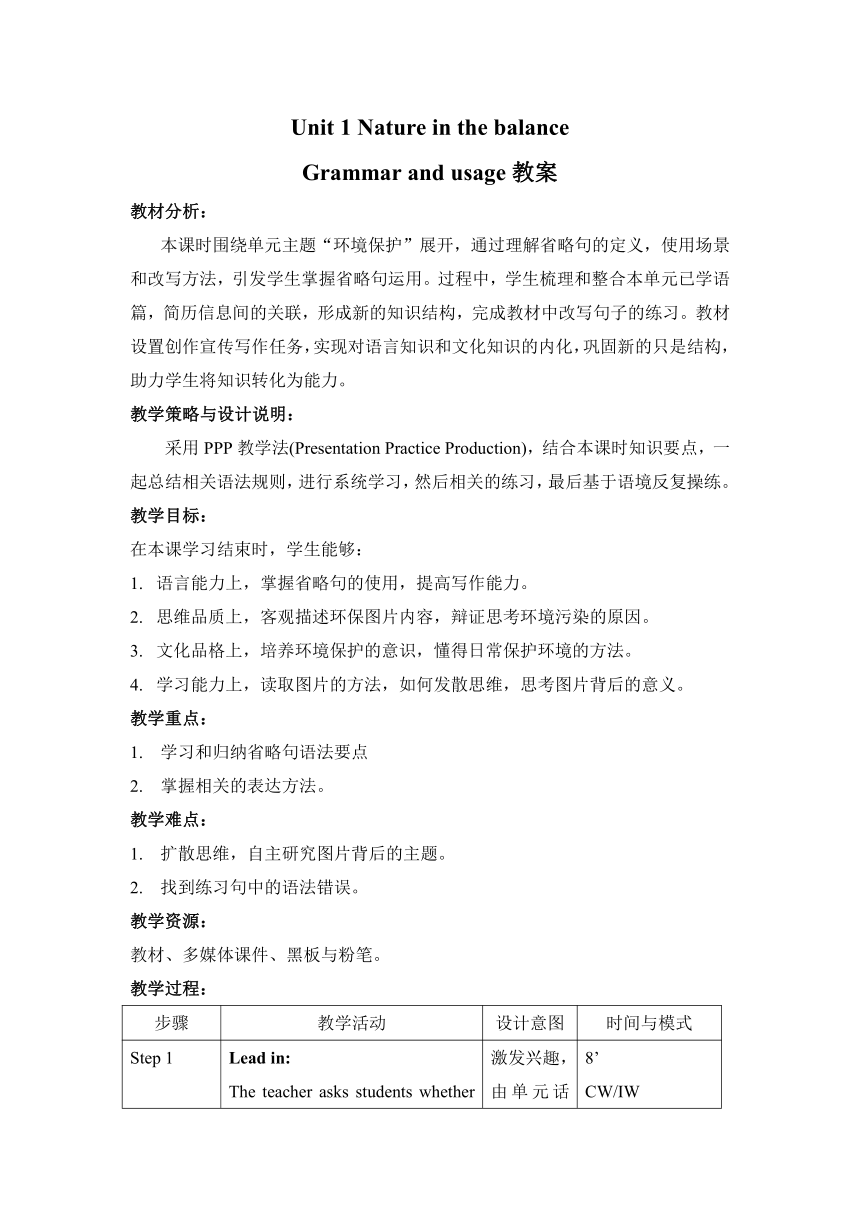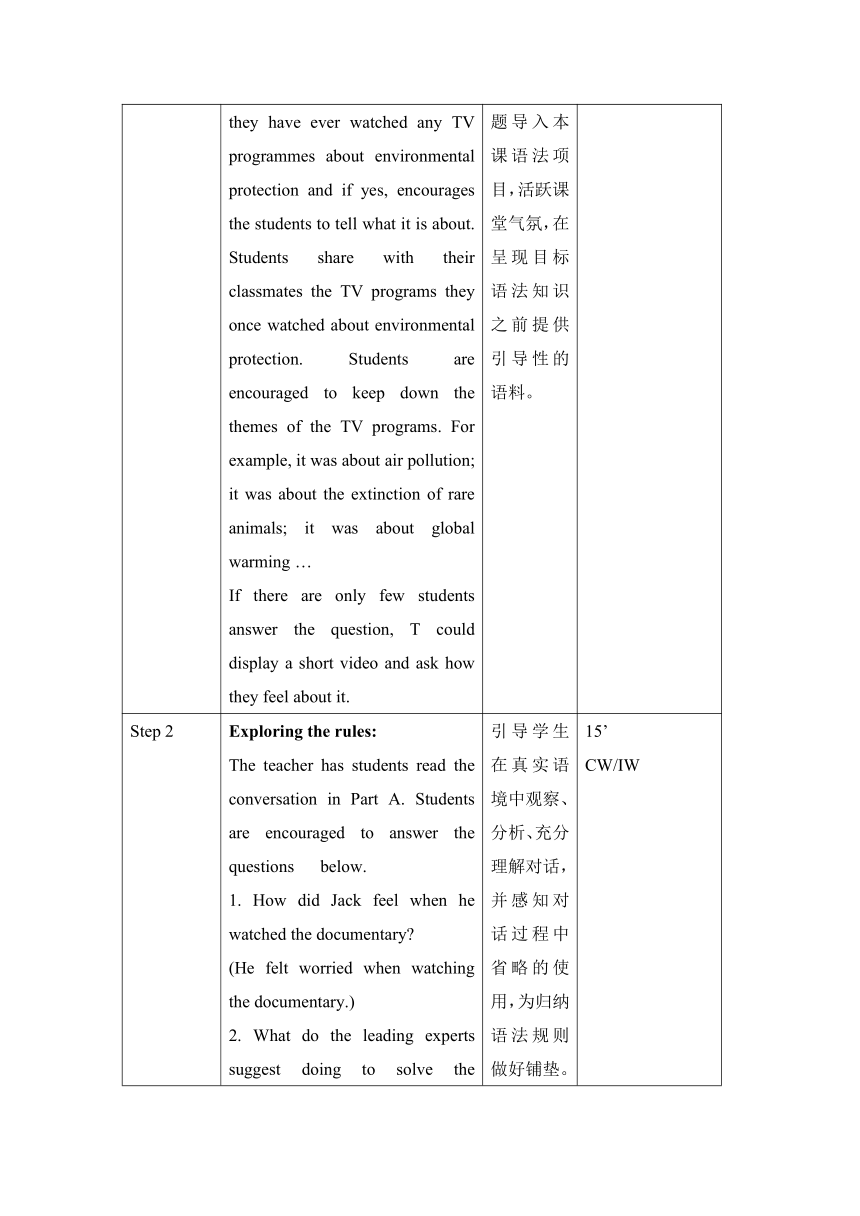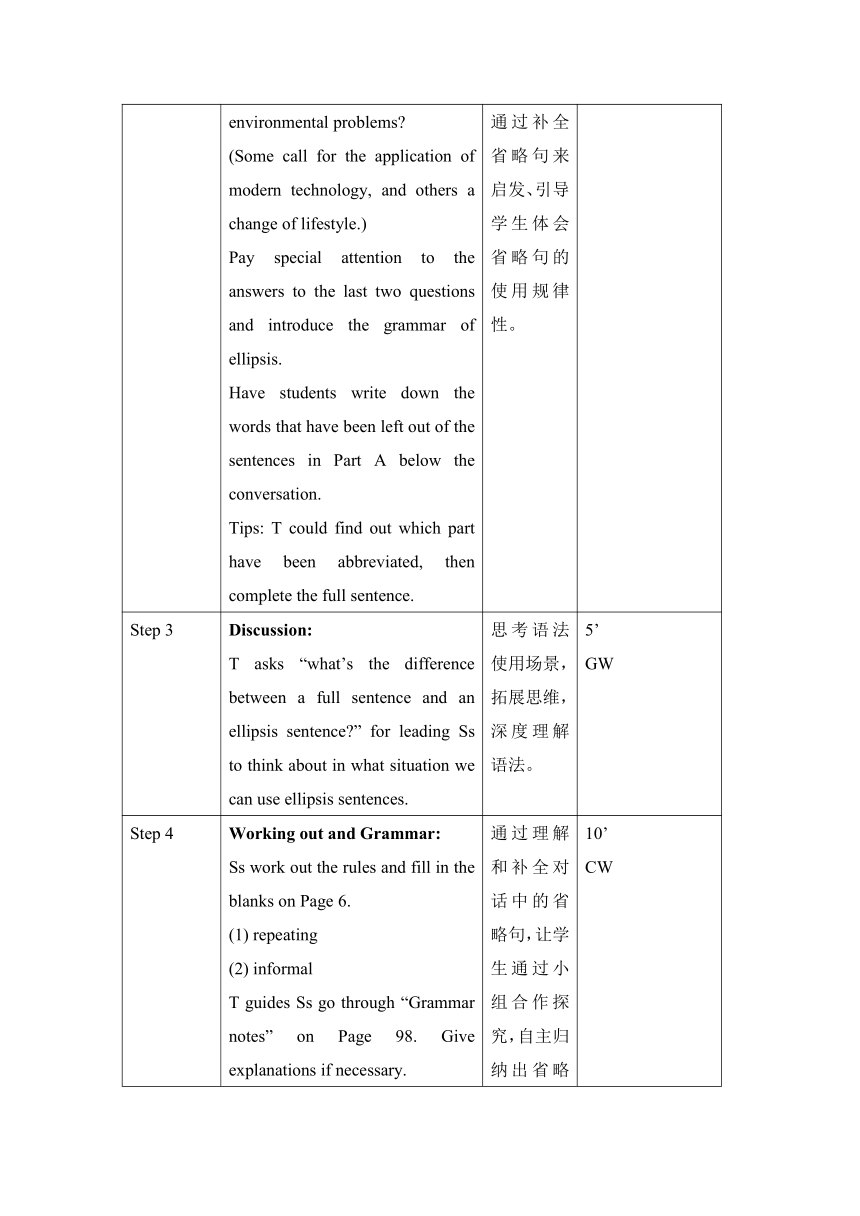牛津译林版(2019)必修 第三册Unit 1 Nature in the balance Grammar and usage教案(表格式)
文档属性
| 名称 | 牛津译林版(2019)必修 第三册Unit 1 Nature in the balance Grammar and usage教案(表格式) |  | |
| 格式 | docx | ||
| 文件大小 | 18.5KB | ||
| 资源类型 | 教案 | ||
| 版本资源 | 牛津译林版(2019) | ||
| 科目 | 英语 | ||
| 更新时间 | 2024-04-03 11:48:49 | ||
图片预览



文档简介
Unit 1 Nature in the balance
Grammar and usage教案
教材分析:
本课时围绕单元主题“环境保护”展开,通过理解省略句的定义,使用场景和改写方法,引发学生掌握省略句运用。过程中,学生梳理和整合本单元已学语篇,简历信息间的关联,形成新的知识结构,完成教材中改写句子的练习。教材设置创作宣传写作任务,实现对语言知识和文化知识的内化,巩固新的只是结构,助力学生将知识转化为能力。
教学策略与设计说明:
采用PPP教学法(Presentation Practice Production),结合本课时知识要点,一起总结相关语法规则,进行系统学习,然后相关的练习,最后基于语境反复操练。
教学目标:
在本课学习结束时,学生能够:
语言能力上,掌握省略句的使用,提高写作能力。
思维品质上,客观描述环保图片内容,辩证思考环境污染的原因。
文化品格上,培养环境保护的意识,懂得日常保护环境的方法。
学习能力上,读取图片的方法,如何发散思维,思考图片背后的意义。
教学重点:
学习和归纳省略句语法要点
掌握相关的表达方法。
教学难点:
扩散思维,自主研究图片背后的主题。
找到练习句中的语法错误。
教学资源:
教材、多媒体课件、黑板与粉笔。
教学过程:
步骤 教学活动 设计意图 时间与模式
Step 1 Lead in: The teacher asks students whether they have ever watched any TV programmes about environmental protection and if yes, encourages the students to tell what it is about. Students share with their classmates the TV programs they once watched about environmental protection. Students are encouraged to keep down the themes of the TV programs. For example, it was about air pollution; it was about the extinction of rare animals; it was about global warming … If there are only few students answer the question, T could display a short video and ask how they feel about it. 激发兴趣,由单元话题导入本课语法项目,活跃课堂气氛,在呈现目标语法知识之前提供引导性的语料。 8’ CW/IW
Step 2 Exploring the rules: The teacher has students read the conversation in Part A. Students are encouraged to answer the questions below. 1. How did Jack feel when he watched the documentary (He felt worried when watching the documentary.) 2. What do the leading experts suggest doing to solve the environmental problems (Some call for the application of modern technology, and others a change of lifestyle.) Pay special attention to the answers to the last two questions and introduce the grammar of ellipsis. Have students write down the words that have been left out of the sentences in Part A below the conversation. Tips: T could find out which part have been abbreviated, then complete the full sentence. 引导学生在真实语境中观察、分析、充分理解对话,并感知对话过程中省略的使用,为归纳语法规则做好铺垫。 通过补全省略句来启发、引导学生体会省略句的使用规律性。 15’ CW/IW
Step 3 Discussion: T asks “what’s the difference between a full sentence and an ellipsis sentence ” for leading Ss to think about in what situation we can use ellipsis sentences. 思考语法使用场景,拓展思维,深度理解语法。 5’ GW
Step 4 Working out and Grammar: Ss work out the rules and fill in the blanks on Page 6. (1) repeating (2) informal T guides Ss go through “Grammar notes” on Page 98. Give explanations if necessary. 通过理解和补全对话中的省略句,让学生通过小组合作探究,自主归纳出省略句使用的意图和目的,找出并识记省略句使用规则,最终习得目标语法结构。 10’ CW
Step 5 Review and summary: T shows the sentences Ss have read, and asks Ss to divide them into difference rules. T checks the answers. Then, Ss answer the three question for reviewing ellipsis. What is ellipsis When can we use ellipsis What’s the function of ellipsis 巩固新知,总结语法。 3’ CW/GW
Step 6 Applying the rules: Have students finish B1 on Page 7 and correct the mistakes and rewrite the sentences using ellipsis. Suggested answers: 1. I cannot watch the documentary this weekend, though I would like to. 2. Cows live on land, and fish in the water. 3. The Amazon rainforest is smaller now than 50 years ago. 4. He had planned to borrow a book on environmental protection, but he didn’t. 5. When taking photos of wildlife, we should make every effort to ensure that we keep away from the animals. 在改错的过程中,逐步加强学生对省略的运用规则和注意细则的理解,帮助学生建立语法系统,体会语言的工具性。 10’ IW/CW
Step 7 Applying the rules: Students read the short passage in B2 on Page 7 and then the teacher asks the students to put brackets around the words that can be left out. 有意义的操练活动能够吸引学生的注意力,同时关注到学习难点,包括形式、意义和用法上的难点,着重培养学生的辨析能力。 5’ IW
Step 8 Role playing: The teacher encourages students to continue Jack and Henry’s conversation on designing a brochure about protecting the environment by using ellipsis where possible. Possible dialogue: Jack: Hi, Henry! Got any good ideas about the brochure Henry: Yes. How about using some pictures and slogans Jack: Sounds great! I can download some while surfing the Internet after school. Henry: OK. E-mail me if you find any and let me take charge of the rest. Jack: Got it! Let’s meet tomorrow afternoon to put it together. 设计巩固操练和实际运用的教学活动,使学生内化语法规则,强化句法意识。 10’ GW
Step 9 Practice: First, T analyses what slogan and calling for are, and shows a post of environmental protection, Ss need to tell what they think of it. Then, Ss appreciate the post one individually and tell what it contains and discuss what the deeper meaning. Next, T needs to analyse the sample passage, and uses different colours to highlight key info. Then, T summarises the three steps to teach Ss how to do the project. And T gives 5 min to lead Ss repeat the process and display the task as an example. After finishing the task, T chooses four Ss to show their answers, and other Ss give suggestions for improving answers. 拓展单元话题的内涵,鼓励学生在后期输出阶段,陈述个性化的观点与策略,自然流露情感,达成语法项目。 20’ IW/CW
Step 10 Homework: Review the rules of ellipsis and draw a picture and think of a slogan to call for the protection of the environment. 1’
备注:
Ss: Students T: Teacher
IW: Individual work GW: Group work CW: Class work
Grammar and usage教案
教材分析:
本课时围绕单元主题“环境保护”展开,通过理解省略句的定义,使用场景和改写方法,引发学生掌握省略句运用。过程中,学生梳理和整合本单元已学语篇,简历信息间的关联,形成新的知识结构,完成教材中改写句子的练习。教材设置创作宣传写作任务,实现对语言知识和文化知识的内化,巩固新的只是结构,助力学生将知识转化为能力。
教学策略与设计说明:
采用PPP教学法(Presentation Practice Production),结合本课时知识要点,一起总结相关语法规则,进行系统学习,然后相关的练习,最后基于语境反复操练。
教学目标:
在本课学习结束时,学生能够:
语言能力上,掌握省略句的使用,提高写作能力。
思维品质上,客观描述环保图片内容,辩证思考环境污染的原因。
文化品格上,培养环境保护的意识,懂得日常保护环境的方法。
学习能力上,读取图片的方法,如何发散思维,思考图片背后的意义。
教学重点:
学习和归纳省略句语法要点
掌握相关的表达方法。
教学难点:
扩散思维,自主研究图片背后的主题。
找到练习句中的语法错误。
教学资源:
教材、多媒体课件、黑板与粉笔。
教学过程:
步骤 教学活动 设计意图 时间与模式
Step 1 Lead in: The teacher asks students whether they have ever watched any TV programmes about environmental protection and if yes, encourages the students to tell what it is about. Students share with their classmates the TV programs they once watched about environmental protection. Students are encouraged to keep down the themes of the TV programs. For example, it was about air pollution; it was about the extinction of rare animals; it was about global warming … If there are only few students answer the question, T could display a short video and ask how they feel about it. 激发兴趣,由单元话题导入本课语法项目,活跃课堂气氛,在呈现目标语法知识之前提供引导性的语料。 8’ CW/IW
Step 2 Exploring the rules: The teacher has students read the conversation in Part A. Students are encouraged to answer the questions below. 1. How did Jack feel when he watched the documentary (He felt worried when watching the documentary.) 2. What do the leading experts suggest doing to solve the environmental problems (Some call for the application of modern technology, and others a change of lifestyle.) Pay special attention to the answers to the last two questions and introduce the grammar of ellipsis. Have students write down the words that have been left out of the sentences in Part A below the conversation. Tips: T could find out which part have been abbreviated, then complete the full sentence. 引导学生在真实语境中观察、分析、充分理解对话,并感知对话过程中省略的使用,为归纳语法规则做好铺垫。 通过补全省略句来启发、引导学生体会省略句的使用规律性。 15’ CW/IW
Step 3 Discussion: T asks “what’s the difference between a full sentence and an ellipsis sentence ” for leading Ss to think about in what situation we can use ellipsis sentences. 思考语法使用场景,拓展思维,深度理解语法。 5’ GW
Step 4 Working out and Grammar: Ss work out the rules and fill in the blanks on Page 6. (1) repeating (2) informal T guides Ss go through “Grammar notes” on Page 98. Give explanations if necessary. 通过理解和补全对话中的省略句,让学生通过小组合作探究,自主归纳出省略句使用的意图和目的,找出并识记省略句使用规则,最终习得目标语法结构。 10’ CW
Step 5 Review and summary: T shows the sentences Ss have read, and asks Ss to divide them into difference rules. T checks the answers. Then, Ss answer the three question for reviewing ellipsis. What is ellipsis When can we use ellipsis What’s the function of ellipsis 巩固新知,总结语法。 3’ CW/GW
Step 6 Applying the rules: Have students finish B1 on Page 7 and correct the mistakes and rewrite the sentences using ellipsis. Suggested answers: 1. I cannot watch the documentary this weekend, though I would like to. 2. Cows live on land, and fish in the water. 3. The Amazon rainforest is smaller now than 50 years ago. 4. He had planned to borrow a book on environmental protection, but he didn’t. 5. When taking photos of wildlife, we should make every effort to ensure that we keep away from the animals. 在改错的过程中,逐步加强学生对省略的运用规则和注意细则的理解,帮助学生建立语法系统,体会语言的工具性。 10’ IW/CW
Step 7 Applying the rules: Students read the short passage in B2 on Page 7 and then the teacher asks the students to put brackets around the words that can be left out. 有意义的操练活动能够吸引学生的注意力,同时关注到学习难点,包括形式、意义和用法上的难点,着重培养学生的辨析能力。 5’ IW
Step 8 Role playing: The teacher encourages students to continue Jack and Henry’s conversation on designing a brochure about protecting the environment by using ellipsis where possible. Possible dialogue: Jack: Hi, Henry! Got any good ideas about the brochure Henry: Yes. How about using some pictures and slogans Jack: Sounds great! I can download some while surfing the Internet after school. Henry: OK. E-mail me if you find any and let me take charge of the rest. Jack: Got it! Let’s meet tomorrow afternoon to put it together. 设计巩固操练和实际运用的教学活动,使学生内化语法规则,强化句法意识。 10’ GW
Step 9 Practice: First, T analyses what slogan and calling for are, and shows a post of environmental protection, Ss need to tell what they think of it. Then, Ss appreciate the post one individually and tell what it contains and discuss what the deeper meaning. Next, T needs to analyse the sample passage, and uses different colours to highlight key info. Then, T summarises the three steps to teach Ss how to do the project. And T gives 5 min to lead Ss repeat the process and display the task as an example. After finishing the task, T chooses four Ss to show their answers, and other Ss give suggestions for improving answers. 拓展单元话题的内涵,鼓励学生在后期输出阶段,陈述个性化的观点与策略,自然流露情感,达成语法项目。 20’ IW/CW
Step 10 Homework: Review the rules of ellipsis and draw a picture and think of a slogan to call for the protection of the environment. 1’
备注:
Ss: Students T: Teacher
IW: Individual work GW: Group work CW: Class work
同课章节目录
- Unit 1 Nature in the balance
- Welcome to the unit
- Reading
- Grammar and usage
- Integrated skills
- Extended reading
- Project
- Unit 2 Natural disasters
- Welcome to the unit
- Reading
- Grammar and usage
- Integrated skills
- Extended reading
- Project
- Unit 3 The world online
- Welcome to the unit
- Reading
- Grammar and usage
- Integrated skills
- Extended reading
- Project
- Unit 4 Scientists who changed the world
- Welcome to the unit
- Reading
- Grammar and usage
- Integrated skills
- Extended reading
- Project
